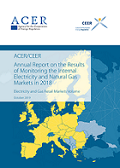Contrary to the previous two years, in 2018 the average energy prices paid by final consumers in the European Union (EU) increased by 3.5% for gas and 1.9% for electricity. The rise reflects an increase in wholesale prices. More than a third of European energy consumes have smart meters, empowering them to play an active role in energy markets and to benefit from greater choice and flexibility.
These are among the key findings presented in the latest Annual Report on the Results of Monitoring the Internal Electricity and Natural Gas Markets. This often-called “Market Monitoring Report" (MMR) is made up of four volumes of which two covering Retail Markets and Consumer Protection and Empowerment, are released today. The Gas Wholesale Market Volume is already published. The fourth Volume, covering the Wholesale Electricity market, will be published next month. The MMR is produced by the EU Agency for the Cooperation of Energy Regulators (ACER) in collaboration with the Council of European Energy Regulators (CEER) and with input from the Energy Community. For some metrics, the Contracting Parties of the Energy Community are also included in the analysis. Beyond presenting the key results of our assessment of the functioning of the Internal Energy Market (IEM) in 2018, the MMR also contains recommendations on how to address the remaining identified barriers to the completion of the IEM.
The energy component is one of the main price drivers of the increase in the energy bill
The energy bill is made of four main elements: the energy component and three so-called non-contestable charges: grid costs, renewables support and taxes. With the non-contestable elements stabilising in the last few years, the energy component seems to be the main driver for price variation in the electricity and gas markets. Differences among EU Member States persist though, and the link between retail and wholesale prices is still weak in some countries.
The MMR also shows that mark-ups, which assess the level of responsiveness of retail energy prices to changes in prices on wholesale markets - for electricity remain, on average, stable, whereas for gas they trended slightly downwards in 2018 compared to 2017.
Among the EU neighbours in South East Europe and the Black Sea region – the Energy Community Contracting Parties - electricity and gas prices for households also rose and contrary to the EU, industrial prices were higher than household prices.
Smart meters empower consumers
Up to 35% of European retail electricity consumers have smart meters - Estonia, Italy, Finland, Norway, Spain and Sweden have reached 80% - and, by 2023, more than 72% of EU consumers are expected to have them. Smart meters allow for innovative service offerings, such as time-of-usage contracts with intraday energy prices differentiation available in 16 Member States. Such ongoing innovation increases the active role of energy consumers as foreseen in the European Commission's Clean Energy Package.
New in this edition of the MMR is a focus on energy poverty as more and more European countries have set a definition for energy poverty so they can develop measures to address it. People affected by energy poverty in the EU ranges from 4% to 14% depending on the Member State.
Market Monitoring Report (MMR) Presentation Event
The full set of MMR, including the remaining Electricity Wholesale Market Volume, will be presented at an event on 20 November in Brussels (register here).



